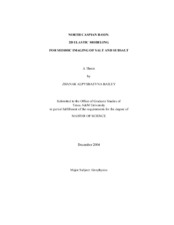| dc.contributor.advisor | Ikelle, Luc T. | |
| dc.creator | Bailey, Zhanar Alpysbaevna | |
| dc.date.accessioned | 2006-04-12T16:01:48Z | |
| dc.date.available | 2006-04-12T16:01:48Z | |
| dc.date.created | 2004-12 | |
| dc.date.issued | 2006-04-12 | |
| dc.identifier.uri | https://hdl.handle.net/1969.1/3064 | |
| dc.description.abstract | The North Caspian Basin (NCB) contains a significant number of major oil
fields, some of which are yet to be put into production. The reason why some of these
fields are not yet put into production is the exploration challenge that the NCB poses. In
particular, the complex geological structure of this region makes it quite difficult to
image its oil fields with conventional seismic techniques. This thesis sheds more light on
difficulties associated with acquiring and processing seismic data in the NCB. The two
central tools for investigation of these imaging challenges were the construction of a
geological model of the NCB and the use of an accurate elastic wave-propagation
technique to analyze the capability of seismic to illuminate the geological structures of
the NCB. Using all available regional and local studies and my knowledge gained with
oil companies, where I worked on subsalt and suprasalt 2D and 3D seismic data from the
North Caspian Basin, I constructed a 2D elastic isotropic 10-by-6 km geological model
of a typical oil field located on the shelf of the Caspian Sea in the southeastern part of
the North Caspian Basin, which has the largest oil fields. We have propagated seismic
waves through this model. The technique we used to compute wave propagation is
known as the Finite-Difference Modeling (FDM) technique. Generating 314 shot gathers
with stationary multicomponent OBS receivers that were spread over 10 km took two
weeks of CPU time using two parallel computers (8 CPU V880 Sun Microsystems and
24 CPU Sun Enterprise). We have made the data available to the public. The dataset can
be uploaded at http://casp.tamu.edu in the SEGY format. The key conclusions of the
analysis of these data are as follows:
- Combined usage of P- and S-waves allows us to illuminate subsalt reef, clastics
and complex salt structures despite the 4-km overburden.
- Free-surface multiples and guided waves are one of the key processing challenges
in NCB, despite relatively shallow (less than 15 m) shelf water. | en |
| dc.format.extent | 17880106 bytes | en |
| dc.format.medium | electronic | en |
| dc.format.mimetype | application/pdf | |
| dc.language.iso | en_US | |
| dc.publisher | Texas A&M University | |
| dc.subject | Caspian | en |
| dc.subject | 2D | en |
| dc.subject | elastic | en |
| dc.subject | multicomponent | en |
| dc.subject | finite-difference | en |
| dc.subject | modeling | en |
| dc.subject | subsalt | en |
| dc.subject | salt | en |
| dc.title | North Caspian Basin: 2D elastic modeling for seismic imaging of salt and subsalt | en |
| dc.type | Book | en |
| dc.type | Thesis | en |
| thesis.degree.department | Geology and Geophysics | en |
| thesis.degree.discipline | Geophysics | en |
| thesis.degree.grantor | Texas A&M University | en |
| thesis.degree.name | Master of Science | en |
| thesis.degree.level | Masters | en |
| dc.contributor.committeeMember | Mamora, Daulat | |
| dc.contributor.committeeMember | Zhan, Hongbin | |
| dc.type.genre | Electronic Thesis | en |
| dc.type.material | text | en |
| dc.format.digitalOrigin | born digital | en |


